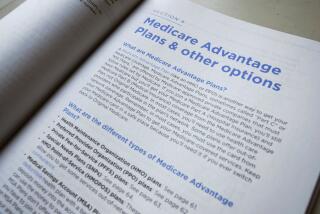Medicare Tests Underused, Study Says
WASHINGTON — Although Medicare pays for preventive tests such as mammograms and colorectal cancer screenings, the vast majority of Medicare beneficiaries do not take advantage of these tests that might someday save their lives, a major national study will report today.
According to the Dartmouth Atlas of Health Care, a detailed annual review of patterns of medical practice, most elderly patients and their doctors are not ordering the tests, even though Medicare will cover all or most of the cost, depending on the procedure.
The low rate of preventive screenings should provide a “wake- up call” for patients to demand better checkups and for doctors to perform preventive care, said Dr. Jonathan Lord, quality expert at the American Hospital Assn., which publishes the atlas.
A study of women ages 65 to 69 found that only 28% had a mammogram during the 1995-1996 period, although they should have them every two years.
Similarly, screening for colorectal cancer, either by a blood test or a colonoscopy, should be performed annually on people 65 or older, but only 12% of the Medicare beneficiaries received the test.
And the approximately 1.7 million Medicare beneficiaries with diabetes should receive annual eye exams, as well as annual glucose level checks and twice-yearly measurement of cholesterol. Yet a survey of the prevalence of eye examinations showed it as low as 25% in some areas.
Health maintenance organizations, although they are targets of criticism on some issues, almost always have better performance records when it comes to screening tests than the traditional fee-for-service Medicare system, in which patients are free to select any doctor who is participating in Medicare, said Dr. John Wennberg of Dartmouth Medical School, the atlas’ editor.
The HMOs typically have better systems for gathering information, and businesses deciding which HMO to select for their workers often pay attention to the screening statistics, Wennberg said.
Nationally, about 15% of the 40 million Medicare beneficiaries are enrolled in HMOs. The figure in California is much higher, about 30%, and the rate exceeds 40% in Los Angeles and Orange counties.
Geography Shown to Be a Factor
The Dartmouth Atlas issued today is the third edition, and it demonstrates that a person’s place of residence strongly influences the likelihood of having preventive screening tests or undergoing various surgical procedures.
“Geography seems to be destiny in health services,” Lord said. “There is not a national system of health care. Instead, we have a lot of local markets where we practice medicine by tradition.”
“As doctors,” he said, “we believe we are doing the right thing, and it is tough for us to change.”
In addition to being screened, older patients should be vaccinated every 10 years for pneumococcal pneumonia, but the rates of vaccination range from 9% to 38%.
Medical directors at managed care organizations attribute their higher preventive care rates to an array of factors including extensive computer systems that track patient care.
“We have reminder systems in place,” said Joel Hyatt, the assistant medical director for clinical services for Kaiser’s Southern California Permanente Medical Group. “When a woman comes in for an appointment, there’s a history of her mammogram schedule, there’s an immediate process where it checks her pap smear records, and if she’s not had [the tests], it is flagged for the nurse or the physician.
“And at some of our medical centers, you don’t leave the medical center until you’ve had them done,” he said.
The benchmark, or best performance, was by Kaiser, which had an 80% rate of providing mammograms in 1995-1996, the period covered by the study.
Kaiser, which has 270,000 Medicare subscribers in Southern California, also has a 58% rate of retinal screening for diabetes patients, considerably higher than the national average.
Reminders Are Less Common
In contrast, patients in fee-for-service Medicare must request tests such as mammograms themselves or rely on their doctors to remind them.
“Prompts and reminders are not part of the fee-for-service system, and that’s one of the aspects of large managed care systems that are often overlooked,” Hyatt said.
Nor do all HMOs have effective screening systems. Some contract for service with a variety of medical groups and record-keeping is not always integrated.
At PacifiCare, which has more than 450,000 members in Southern California, the mammogram rate for Medicare subscribers is roughly 70% and retinal screening for diabetes patients is well over 50%, said Dr. Sam Ho, corporate medical director for PacifiCare Health Systems.
Ho said managed care companies educate doctors in appropriate practice guidelines, giving them information about how their activities--such as rates of screening tests--compare with their peers and with desired standards. PacifiCare also has a reminder system for doctors and patients similar to that of Kaiser.
“The quality of care is a problem, not managed care,” Ho said. “At least we have a system set up to reduce variability and improve the mean performance . . . we have report cards for doctors and patients, we have outreach for seniors and systems of care,” he said.
The Dartmouth Atlas studies Medicare patients because the best set of national health care data is available for the 40 million people enrolled in Medicare--those over 65 and the disabled of all ages.






